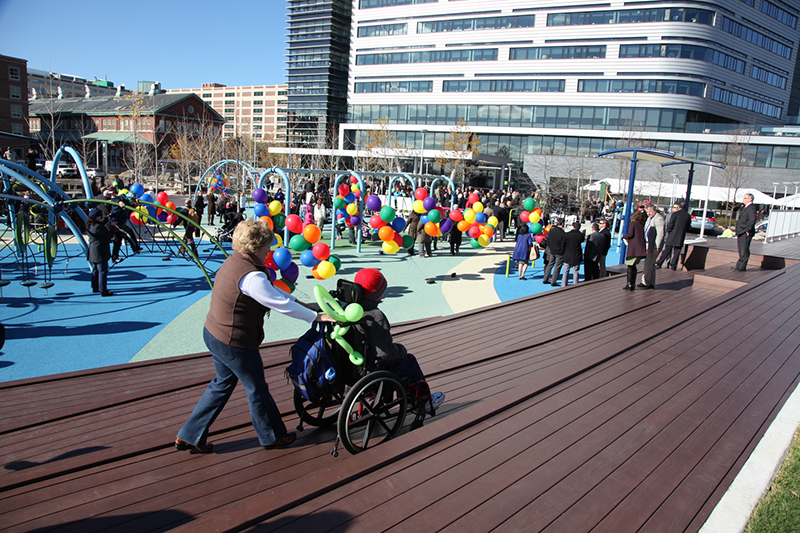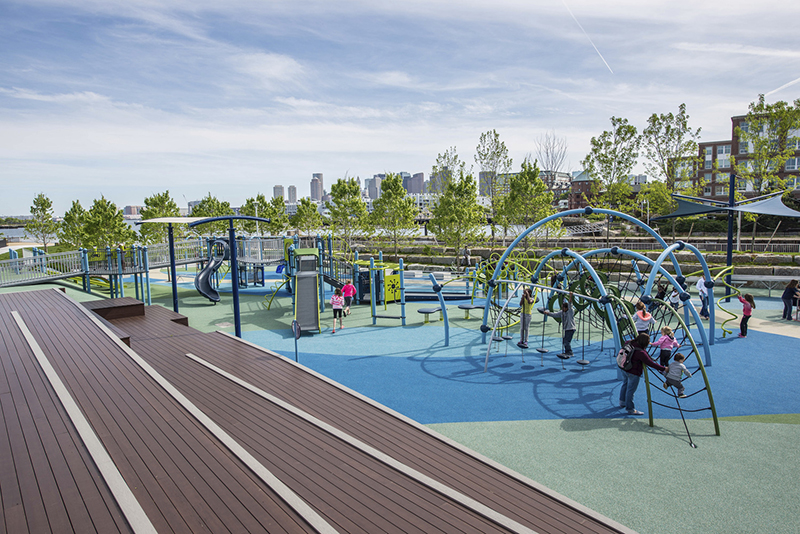
Principles of inclusive playground design - by Cheri Ruane

Inclusive (or universal) playgrounds can be defined as those that address the needs of all users, including people of all ages with autism, intellectual disabilities, hearing impairments, cerebral palsy, spina bifida, and other emotional or physical disabilities, as well as their caregivers. The concept also addresses the needs of more typical children. Inclusive playgrounds accommodate everyone and challenge them at their own developmental level.
The goal of designing inclusive playgrounds is to maximize each facility’s usability by individuals with a wide variety of characteristics. Whether we are talking about learning strategies or physical space, inclusive design operates by a set of principles designed to maximize access by everyone, alongside their family and friends.

Equitable Use: The principle of equitable use means that the design is useful and marketable to people with a wide range of abilities. For example, a multi-level water table accommodates users of different heights and abilities including those in wheelchairs. Ensuring adequate clearance for mobility devices is an important component.
Flexibility in Use: Flexible design in inclusive playgrounds means that the design accommodates a wide range of individual preferences and abilities, including low to high-risk takers. On elevated play structures, for example, a flexible design would provide different means of access to an elevated portion, such as a rock wall, steps, or a wheelchair ramp.
Simple and Intuitive Use: Inclusive design includes play areas and structures that are easy to understand, regardless of the user’s experience, knowledge, language skills, or current concentration level. For example, for people in wheelchairs, it should be obvious that the transfer steps and handrails for certain activities are meant to support their engagement.
Perceptible Information: Inclusive design should easily communicate necessary information effectively to the user, regardless of ambient conditions or the user’s sensory abilities. One example is the use of different colors to indicate the intensity of experience on specific pieces of play equipment. For tall slides and speedy spinners, a warmer color indicates a high level of intensity. At the water table or musical instruments, a cooler color signals a calmer environment.

Tolerance for Error: Inclusive design minimizes hazards and the adverse consequences of accidental or unintended actions. Children are always looking for ways to use playground equipment in ways that the designers had not intended. Can the child make a mistake using the equipment and not get hurt? This must be carefully balanced, however, with a kid’s innate desire to take risks and do things that are outside their comfort zone.
Low Physical Effort: Inclusive design allows for the use of the playground equipment efficiently, comfortably, and with a minimum of fatigue. Users should be able to exert all the energy they would like once they get to a specific place in the play environment. However, an uneven access path, for example, could tire out users in wheelchairs or on crutches before they even get to where they want to go, which can cause frustration.
Appropriate Size and Space for Approach and Use: Inclusive designs provide adequate size and space for approach, reach, and manipulation, regardless of physical characteristics such as size or mobility. Because of the space needs of the users of inclusive playgrounds, both in accessing and experiencing the spaces, accommodations must be made. Such designs, for example, would provide ample space to park a wheelchair or walker while the child engages with water or music play. Another example might be that users who are not very steady on their feet may need a larger standing area on the equipment than more able-bodied users.
No matter the size or shape of an inclusive playground, there are always ways to design it so that it can be used and enjoyed by a wide range of abilities. All it takes is some thought, some good ideas, and a little bit of creative thinking.
For more information on the topic of inclusive playground design, a reference article from the National Center on Accessibility is entitled “Designing for Inclusive Play: Applying the Principles of Universal Design to the Playground.”
Cheri Ruane, FASLA, is a vice president and design discipline lead at Weston & Sampson’s Design Studio, Boston, Mass.